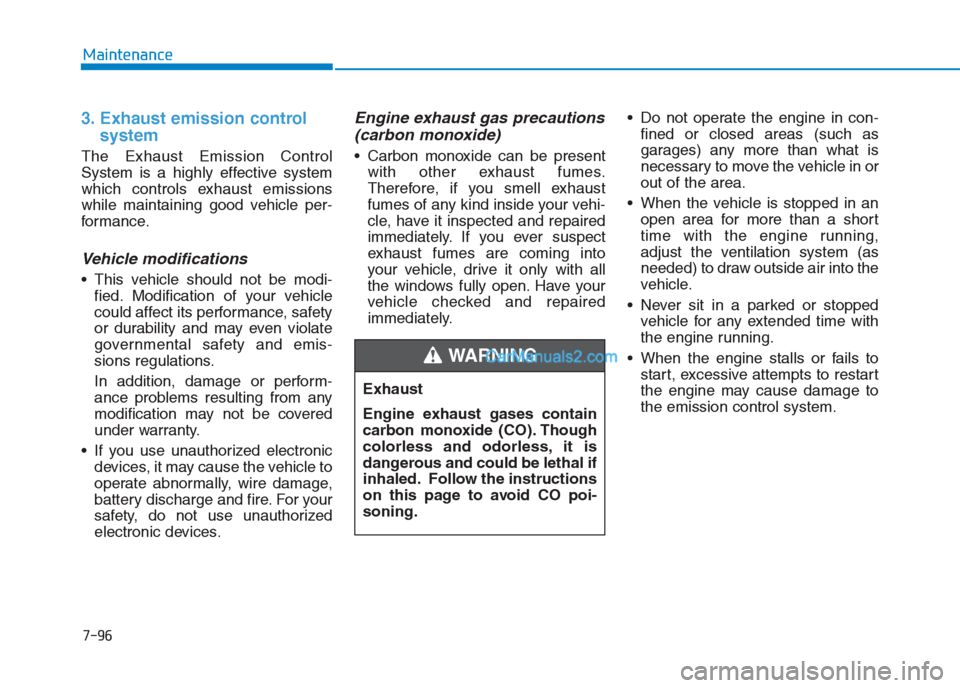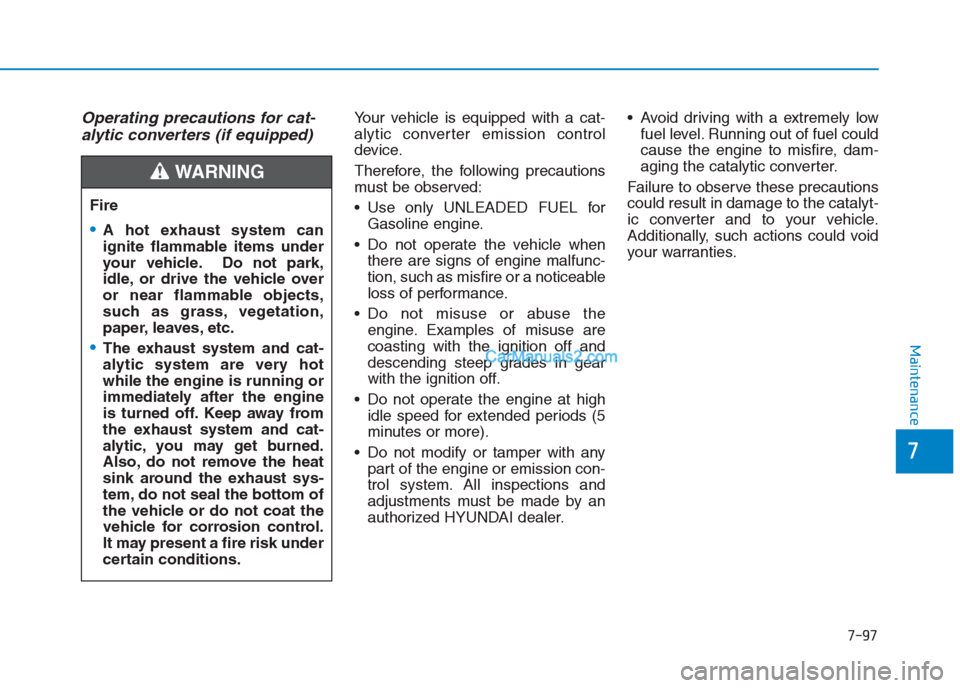2019 Hyundai Creta warnin
[x] Cancel search: warninPage 438 of 472

7-81
7
Maintenance
Information
If the headlight aiming adjustment is
necessary after the headlight assembly
is reinstalled, consult an authorized
HYUNDAI dealer.
Headlight (Low/High) and static
bending light replacement
1. Open the hood.
2. Remove the headlight bulb cover
by turning it counterclockwise.
3. Disconnect the headlight bulb
socket-connector.
4. Unsnap the headlight bulb retain-
ing wire by depressing the end
and pushing it upward.
5. Remove the bulb from the head-
light assembly.
i
(Continued)
Always handle them carefully,
and avoid scratches and abra-
sions. If the bulbs are lit, avoid
contact with liquids. Never
touch the glass with bare
hands. Residual oil may cause
the bulb to overheat and burst
when lit. A bulb should be
operated only when installed
in a headlight.
If a bulb becomes damaged or
cracked, replace it immediate-
ly and carefully dispose of it.
Wear eye protection when
changing a bulb. Allow the
bulb to cool down before han-
dling it.Halogen bulbs
Halogen bulbs contain pres-
surized gas that will produce
flying pieces of glass if bro-
ken.
(Continued)
WARNING
OLMB073042L
OGS075051
Static bending light
Turn signal
Low/High
Page 444 of 472

7-87
7
Maintenance
1. Using a flat-blade screwdriver,
gently pry the lens from the interi-
or lamp housing.
2. Remove the bulb by pulling it
straight out.3. Install a new bulb in the socket.
4. Align the lens tabs with the interior
lamp housing notches and snap
the lens into place.
Use care not to dirty or damage
lens, lens tab, and plastic hous-
ings.
NOTICE
Prior to working on the Interior
lamps, ensure that the “OFF”
button is depressed to avoid
burning your fingers or receiv-
ing an electric shock.
WARNING ■Room lamp
■Luggage room lamp OGS075049
OGS075048
Page 445 of 472

7-88
Maintenance
A AP
PP
PE
EA
AR
RA
AN
NC
CE
E
C
CA
AR
RE
E
Exterior care
Exterior general caution
It is very important to follow the label
directions when using any chemical
cleaner or polish. Read all warning
and caution statements that appear
on the label.
Finish maintenance
Washing
To help protect your vehicle’s finish
from rust and deterioration, wash it
thoroughly and frequently at least
once a month with lukewarm or cold
water.
If you use your vehicle for off-road
driving, you should wash it after each
off-road trip. Pay special attention to
the removal of any accumulation of
salt, dirt, mud, and other foreign
materials. Make sure the drain holes
in the lower edges of the doors and
rocker panels are kept clear and
clean.
Insects, tar, tree sap, bird droppings,
industrial pollution and similar
deposits can damage your vehicle’s
finish if not removed immediately.
Even prompt washing with plain
water may not completely remove all
these deposits. A mild soap, safe for
use on painted surfaces, may be
used.
After washing, rinse the vehicle thor-
oughly with lukewarm or cold water.
Do not allow soap to dry on the finish. Do not use strong soap, chemi-
cal detergents or hot water, and
do not wash the vehicle in direct
sunlight or when the body of the
vehicle is warm.
Be careful when washing the
side windows of your vehicle.
Especially, with high-pressure
water, water may leak through
the windows and wet the interior.
To prevent damage to the plastic
parts and lamps, do not clean
with chemical solvents or strong
detergents.
NOTICE
Wet brakes
After washing the vehicle, test
the brakes while driving slowly
to see if they have been affected
by water. If braking performance
is impaired, dry the brakes by
applying them lightly while main-
taining a slow forward speed.
WARNING
Page 447 of 472

7-90
Maintenance
Bright-metal maintenance
To remove road tar and insects,
use a tar remover, not a scraper or
other sharp object.
To protect the surfaces of bright-
metal parts from corrosion, apply a
coating of wax or chrome preser-
vative and rub to a high luster.
During winter weather or in coastal
areas, cover the bright metal parts
with a heavier coating of wax or
preservative. If necessary, coat the
parts with non-corrosive gasoli-
neeum jelly or other protective
compound.
Underbody maintenance
Corrosive materials used for ice and
snow removal and dust control may
collect on the underbody. If these
materials are not removed, acceler-
ated rusting can occur on the under-
body parts such as the fuel lines,
frame, floor pan and exhaust system,
even though they have been treated
with rust protection.
Thoroughly flush the vehicle under-
body and wheel openings with luke-
warm or cold water once a month,
after off-road driving and at the end
of each winter. Pay special attention
to these areas because it is difficult
to see all the mud and dirt. It will do
more harm than good to wet down
the road grime without removing it.
The lower edges of the doors, rocker
panels, and frame members have
drain holes that should not clog with
dirt; trapped water in these areas can
cause rusting.After washing the vehicle, test
the brakes while driving slowly
to see if they have been affected
by water. If braking performance
is impaired, dry the brakes by
applying them lightly while
maintaining a slow forward
speed.WARNING
Page 453 of 472

7-96
Maintenance
3. Exhaust emission control
system
The Exhaust Emission Control
System is a highly effective system
which controls exhaust emissions
while maintaining good vehicle per-
formance.
Vehicle modifications
This vehicle should not be modi-
fied. Modification of your vehicle
could affect its performance, safety
or durability and may even violate
governmental safety and emis-
sions regulations.
In addition, damage or perform-
ance problems resulting from any
modification may not be covered
under warranty.
If you use unauthorized electronic
devices, it may cause the vehicle to
operate abnormally, wire damage,
battery discharge and fire. For your
safety, do not use unauthorized
electronic devices.
Engine exhaust gas precautions
(carbon monoxide)
Carbon monoxide can be present
with other exhaust fumes.
Therefore, if you smell exhaust
fumes of any kind inside your vehi-
cle, have it inspected and repaired
immediately. If you ever suspect
exhaust fumes are coming into
your vehicle, drive it only with all
the windows fully open. Have your
vehicle checked and repaired
immediately. Do not operate the engine in con-
fined or closed areas (such as
garages) any more than what is
necessary to move the vehicle in or
out of the area.
When the vehicle is stopped in an
open area for more than a short
time with the engine running,
adjust the ventilation system (as
needed) to draw outside air into the
vehicle.
Never sit in a parked or stopped
vehicle for any extended time with
the engine running.
When the engine stalls or fails to
start, excessive attempts to restart
the engine may cause damage to
the emission control system. Exhaust
Engine exhaust gases contain
carbon monoxide (CO). Though
colorless and odorless, it is
dangerous and could be lethal if
inhaled. Follow the instructions
on this page to avoid CO poi-
soning.
WARNING
Page 454 of 472

7-97
7
Maintenance
Operating precautions for cat-
alytic converters (if equipped)Your vehicle is equipped with a cat-
alytic converter emission control
device.
Therefore, the following precautions
must be observed:
Use only UNLEADED FUEL for
Gasoline engine.
Do not operate the vehicle when
there are signs of engine malfunc-
tion, such as misfire or a noticeable
loss of performance.
Do not misuse or abuse the
engine. Examples of misuse are
coasting with the ignition off and
descending steep grades in gear
with the ignition off.
Do not operate the engine at high
idle speed for extended periods (5
minutes or more).
Do not modify or tamper with any
part of the engine or emission con-
trol system. All inspections and
adjustments must be made by an
authorized HYUNDAI dealer. Avoid driving with a extremely low
fuel level. Running out of fuel could
cause the engine to misfire, dam-
aging the catalytic converter.
Failure to observe these precautions
could result in damage to the catalyt-
ic converter and to your vehicle.
Additionally, such actions could void
your warranties. Fire
A hot exhaust system can
ignite flammable items under
your vehicle. Do not park,
idle, or drive the vehicle over
or near flammable objects,
such as grass, vegetation,
paper, leaves, etc.
The exhaust system and cat-
alytic system are very hot
while the engine is running or
immediately after the engine
is turned off. Keep away from
the exhaust system and cat-
alytic, you may get burned.
Also, do not remove the heat
sink around the exhaust sys-
tem, do not seal the bottom of
the vehicle or do not coat the
vehicle for corrosion control.
It may present a fire risk under
certain conditions.
WARNING
Page 466 of 472

I-2
Accessing your vehicle ...................................................3-3
Immobilizer system ...................................................3-12
Remote key ..................................................................3-3
Remote key precautions...............................................3-5
Smart key .....................................................................3-7
Smart key precautions ...............................................3-10
Air bag-supplemental restraint system (SRS) ..............2-43
Air bag warning and indicator ...................................2-48
Air bag warning label ...............................................2-65
Curtain air bag ..........................................................2-56
Do not install a child restraint on the front
passenger's seat ........................................................2-47
Driver's and passenger's front air bag .......................2-52
How does the air bag system operate .......................2-45
Side impact air bag ...................................................2-55
SRS Care....................................................................2-63
SRS components and functions .................................2-48
Air cleaner ....................................................................7-41
Filter replacement ....................................................7-41
Air conditioner compressor label .................................8-10Appearance care ...........................................................7-88
Exterior care...............................................................7-88
Interior care................................................................7-93
Audio (With Touch Screen) ..........................................4-33
Feature of Your Audio ...............................................4-34
Media .........................................................................4-40
Phone ........................................................................4-49
Radio ..........................................................................4-38
Setup ..........................................................................4-57
Audio (Without Touch Screen).......................................4-8
Feature of Your Audio .................................................4-9
Media .........................................................................4-15
Phone .........................................................................4-22
Radio ..........................................................................4-14
Radio Mode ...............................................................4-14
Setup ..........................................................................4-30
Automatic transaxle ......................................................5-23
Automatic transaxle operation ...................................5-24
Good driving practices...............................................5-28
Parking .......................................................................5-28
Index
A
Page 467 of 472

I-3
Battery...........................................................................7-47
Battery capacity label ................................................7-49
Battery recharging......................................................7-49
For best battery service ..............................................7-47
Reset items .................................................................7-50
Before driving .................................................................5-3
Before entering the vehicle ..........................................5-3
Before starting .............................................................5-3
Brake/clutch fluid .........................................................7-37
Checking the brake/clutch fluid level ........................7-37
Braking system .............................................................5-30
Anti-lock Brake System (ABS) .................................5-34
Disc brakes wear indicator ........................................5-31
Electronic Stability Control (ESC) ............................5-36
Good braking practices ..............................................5-42
Hill-Start Assist Control (HAC) ................................5-41
Parking brake .............................................................5-31
Power brakes..............................................................5-30
Rear drum brakes .......................................................5-31
Vehicle Stability Management ...................................5-40
Bulb wattage ...................................................................8-3Child restraint system ...................................................2-31
Children always in the rear .......................................2-31
Installing a Child Restraint System (CRS) ................2-33
Climate control air filter ...............................................7-42
Filter inspection .........................................................7-42
Filter replacement ......................................................7-42
Climate control system .................................................3-95
Automatic climate control system ...........................3-105
Defroster ....................................................................3-95
Manual climate control system ..................................3-96
Windshield defrosting and defogging ......................3-116
Cruise control ...............................................................5-43
Cruise control operation ............................................5-43
Declaration of conformity ............................................4-59
CE REd For EU .........................................................4-59
FCC Warning .............................................................4-60
IFETEL for Mexico ...................................................4-61
Dimensions .....................................................................8-2
I
Index
BC
D